I expected two more solid, but not stressed, weeks of writing before the Electric Eye User Manual would be completed and I could move on to a new project.
| Chiang Kai Shek Memorial |
|---|
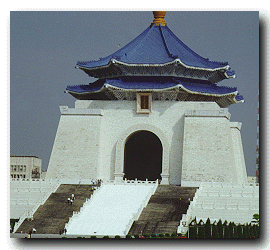 |
The manual had been a pleasure to write. After five months with the company it was about time that I really began to get a full grasp of our main product. Writing the user manual was just about the perfect way for me to learn such a complex program.
If you want to read the introduction to the user manual to see what it is that Electric Eye does, just click here
At any rate, after a quick run through email, I opened up chapter_eight.doc and picked up where I'd left off.
...
| Chiang Kai Shek Memorial |
|---|
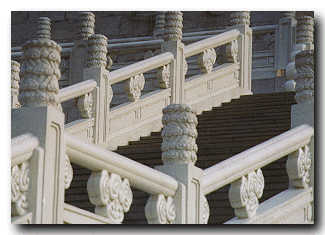 |
Unfortunately, my comfortable two weeks/two hundred pages schedule was not meant to be. Soon after I began writing my boss Andrew came in and told me that I would be leaving for Kaohsiung on the Southern coast of Taiwan on Friday morning.
"How is the user manual coming?"
"Okay, I sent off the rough draft to Kris Kinney last week and I should have the last two chapters done by the end of the month."
"Can you have it done by Friday?"
"Why?"
"You are going to Taiwan with Cyboon and SL Tan for a month. You also need to get the paper work taken care of."
"Uh..."
"Talk to Cyboon about getting your plane tickets."
And that was it. I found out from Cyboon what exactly the project was.
| Rick Eating Syrrup Drenched Strawberies |
|---|
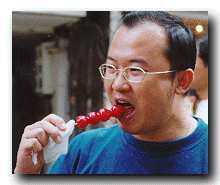 |
On the outskirts of Kaohsiung a new university was being built. The new university consisted of four primary buildings which were having some new experimental, intelligent air conditioning systems installed in them.
Traditional, basic air conditioning systems work something like this: Water is cooled in a "cooling tower" which sucks heat out of the water and then disperses the heat into the outside air. The cooled water is then piped into a building through a series of pipes, pumps and valves. The cooled water goes to a "Chiller" which then blows the coldness off the water and into the air conditioning vents. The warmed water is then sent back to the cooling tower to get chilled again. And the cycle goes round and round like that
S.L. Tan, one of our project engineers had already been on site for a month installing an "ENFLEX monitoring and control system" which essentially provides an interface to each of the parts in this system.
| Lanterns |
|---|
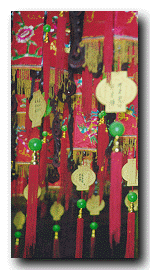 |
For example, if you wanted to allow more chilled water to flow through Pump A, you could send a signal to Pump A to open itself up by using ENFLEX.
ENFLEX is convenient because rather than going down to the basement to turn on some rusty, dusty pump manually, you can just tell ENFLEX to do it.
ENFLEX is also used to collect information about the system itself rather than just to control it.
For example, not only can you use ENFLEX to manipulate pieces in the system, you can also glean and archive information about their state such as what temperature is being registered in and out of Chiller A or whether some bit like Valve B is turned on or off.
| Street Scene |
|---|
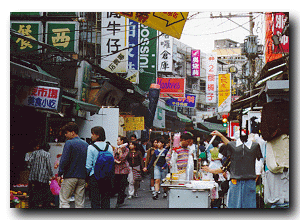 |
Thus, all of this information and control could be manipulated by some person in some lab who operated a switch board-like thingamajig.
The installation and manipulation of ENFLEX is one of the foundations of Electric Eye. We are probably ENFLEX's largest customers as we use ENFLEX to collect the data which is analyzed by Electric Eye.
And if the project required only a standard installation, I would never have been needed. However, Taiwan presented some interesting new problems.
For one, Taiwan presents an interesting exception in utilities metering. In the country, utility rates are a function of the time of the day. Specifically, electricity is cheaper at night.
Dr. Yang of Sun Yat Sen University and his crew of Ph.D. students had devised a way to run the buildings at a much reduced price by using ice makers at night to make ice which could be melted during the day to affect cooling of the buildings. Thus, cooli ng towers could be turned off during the expensive daylight hours and buildings could use the ice to cool them off.
| Kids Playing |
|---|
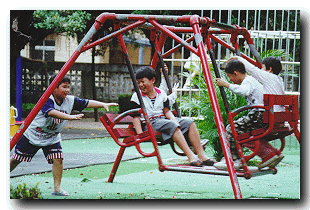 |
In and of itself, this would add a great deal of complexity to the ENFLEX system. However, Dr Yang wanted more.
Firstly, Dr Yang wanted to utilize distributed intelligence such that if one building had used up its ice supply and another building still had an abundance, that one building could request ice from the other and have it provided by a common pipe. Note t hat this is one building requesting ice from another, not one person requesting ice from another!
Further, all networked buildings should be controllable and configurable over the web by the research students who would be testing, recording and monitoring the state of the buildings.
Finally, all buildings were requited to have the intelligence to run by themselves according to a predefined schedule under normal circumstances and to react in a number of ways in abnormal situations. Such reactions included paging engineers during fail ures and conducting complex and touchy reboot and shut down procedures by themselves if necessary.
In future months, an intelligent system of predicting load demand would also be implemented so that buildings could guess what type of load to expect the next day (based on load measurements for yesterday, last week, last month and last year) and vary the ir ice production activity accordingly.
| Door |
|---|
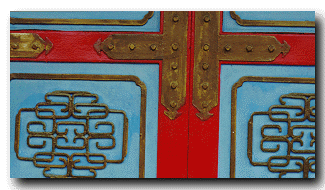 |
At any rate, now that SL Tan had set up all the hardware, Cyboon and I were called in to write the programs which would make all of this work.
Cyboon would handle making the connection from the hardware (Pumps, Valves, etc) via ENFLEX to me and I would handle the program which a user could use to manipulate and monitor all the hardware.
The idea of the project was fascinating, the least of which was the fact that it was an entirely new type of programming for me. In the past, I'd written programs that were used by people. One of the consequences of that was that if there was a bug in t he program, the worst thing that happened was that some person was inconvenienced and I had to write a fix. In this case, things were somewhat different. In this case, I was coding for machines not people and if there was a bug in the program a multi-mi llion dollar machine could break.
At any rate, writing went well that week and I finished a good, quality 150 pages in four days and sent off the draft of the user manual to our clients in San Francisco who understood my not being able to completely finish and who thankfully said that the y would figure out the rest.
On Thursday night I finally got a solid 5 hours of sleep and was off to Changi airport bright and early on Friday morning.
| CKS Memorial |
|---|
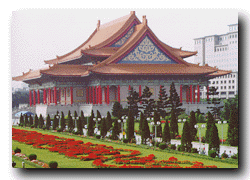 |
At Changi, I met Cyboon and we discussed the electrical engineering control systems theory which would be the basis of the programs we were writing while we waited for the boarding call. We were supposed to finish the discussion on board but I fell aslee p sometime before takeoff I think.
With an achy back, I collected my bags on the carrousel and joined Cyboon in the immigration line and out to the arrival hall where we met S.L Tan (a.k.a. Rick) and the graduate student in charge of the project, Wilson. They grabbed our extra bags (we'd shipped up a couple of SGI CPU's in our luggage to avoid customs and taxes) and we made our way to Hotel Major in downtown Kaohsiung.
Kaohsiung, the city, can be summed up as industrial doldrums. The city is probably the most ugly and boring places I've ever been. There are few attractions, little nightlife, a constant cloak of industrial haze (which could be seen from one end of the hotel room to the other), and a sad lack of TV programming. The food is also greasier than Spain and incorporates two eggs in every single meal which makes it all taste the same. Like any regional industrial sloth pit it suffers from the I want to be a cosmopolitan city like Taipei syndrome which causes people to act, dress and relate in gaudy, wannabe, nuevo riche sort's of ways.
The work, however, was invigorating. We borrowed a few monitors from the campus and set up a local area network in the hotel between our three hotel rooms, the LAN cable going out from underneath the doors from one room to another.
| Durian |
|---|
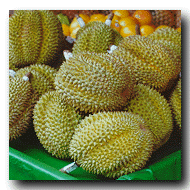 |
Programming sessions went far into the mornings as the little green lights on the Ethernet cable kept flashing away with a "I will outlast you" dare from the rooms next door.
Typically, we would arise at 6 AM with a few hours of sleep and ride out to the university where we would conduct tests before the student body began arriving. We would then work and take intermittent cat naps throughout the day, do a final test after th e students left and return to the hotel for the evening.
You can imagine that after few days things started getting extremely surreal. nights blended into days as dreams blended into reality. I started dreaming programmatic modifications and finding that when I woke up, I remembered the modifications and coul d implement them.
| Dress Pattern |
|---|
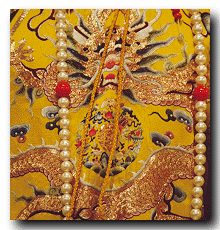 |
One of the greatest pleasures was when we arrived at the university in the morning, the computer room would be full of mosquitoes and flies. We had purchased these electronic mosquito swatters which looked like tennis rackets and could be used to kill mo squitoes. The threads of the racket portion were electrified with a could of double A batteries in the handle and if you swatted them near a mosquito, the static would suck the mosquito into the net and it would explode when it touched with a big pop.
Okay, well, seriously un PC but it was just what we needed in those early mornings in the room infested with mosquitoes.
Our one highlight was on the last weekend when the three of us went up to Taipei to meet with some other clients. Though Dave was still caught in immigration hell, I did have a chance to stop by and hang out with Leivin a bit. He was a bit under the wea ther as he had popped a vein in his leg which had gotten infected but he was a great host and Cyboon, Rick and I stayed late at a party he hosted.
The Taiwanese expat community is both similar and different from the one in Singapore. Since English is a much more desired skill in Taiwan, the majority o the expats seemed to be English teachers who were at some point in their traveling. The teaching was a dish-washer type job which allowed them to travel in Asia. In Singapore, everyone already speaks English so fewer expats are teachers. Mainly, the expat community is comprised of bankers, analysts and IT professionals. In the end, you get a grubb ier expat community in Taiwan.
| Pattern |
|---|
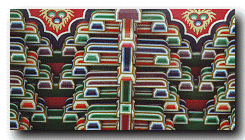 |
Of course, I prefer the grubbier people so I enjoyed myself and will certainly go back. And, of course, I have to say that having spent a dry 7 months in Singapore made the local Taiwanese herb quite a treat. You can always count on Dave and Leivin I su ppose.
Besides having a good time with Leivin, the city of Taipei is far more interesting that Kaohsiung. In fact, it is a real post-modern Asian city with all of the crammed, throbbing, glowing streets one would expect.
We stayed in Sementing which was one of the hot areas of town (perhaps a red light district in its own) and the throng was greatly appreciated after Kaohsiung. Food stalls were open 24-7 and activity was all around. We were also only a short walk to th e tourist type attractions so we did that on Saturday morning.
At any rate, after the weekend in Taipei, we returned to Singapore. Rick and CyBoon's Visas had run out and I needed to pack for my trip to Tokyo. The work was a solid half way done and we already had our tickets to return to Kaohsiung at the end of the month.